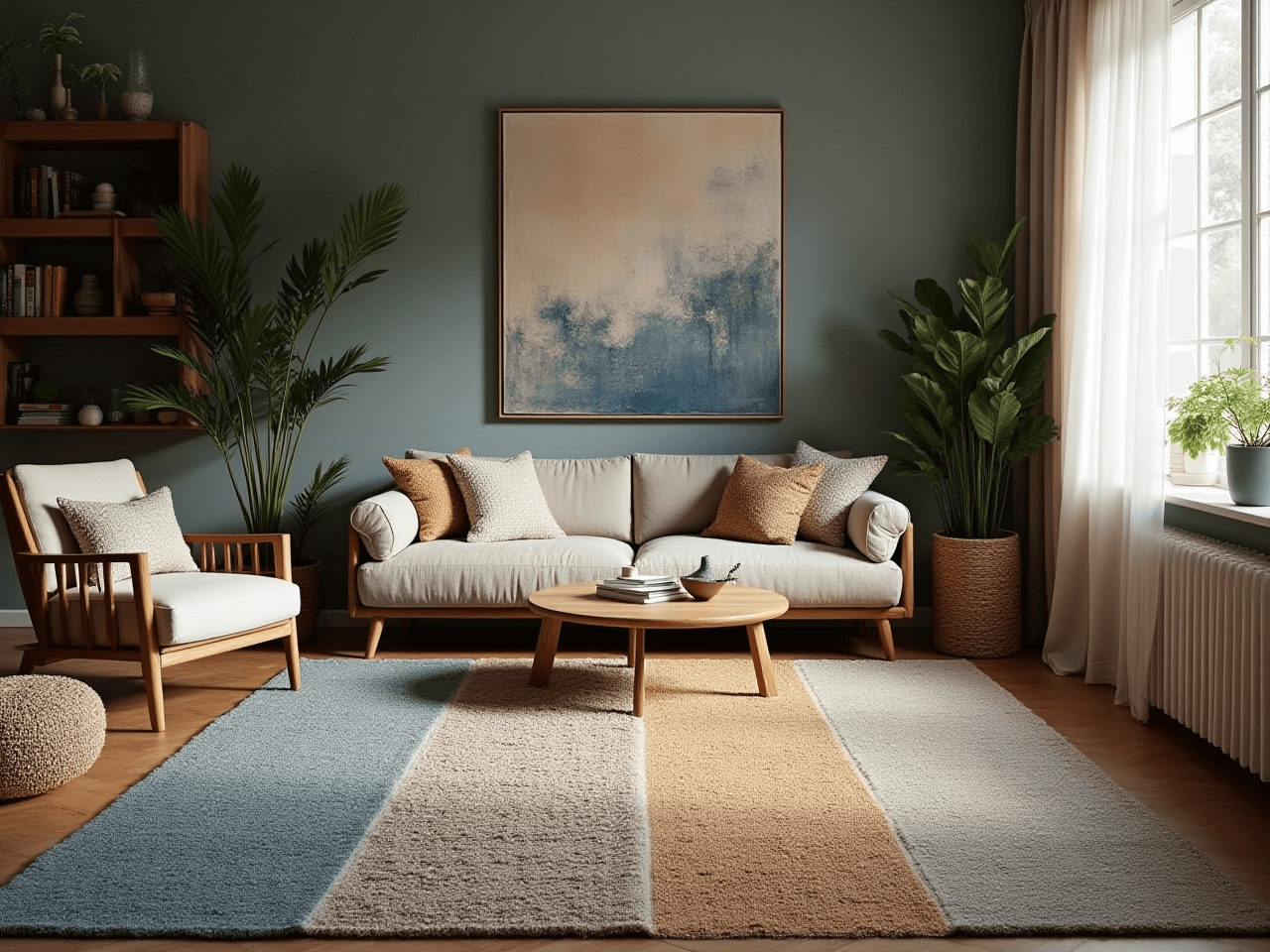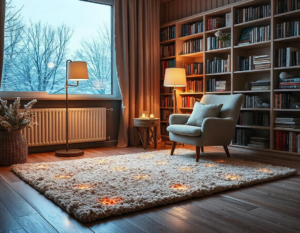Rugs have a magical way of tying a room together, adding charm, comfort, and warmth to any space. But choosing the right rug material for your home, especially in India, is more complex than it seems. The climate, foot traffic, and household needs play significant roles in deciding whether jute, wool, or synthetic rugs will work best for you.
This guide will help you compare the most popular rug materials for Indian homes, their pros and cons, and how to select the perfect one when buying online.
Why the Right Rug Material Matters
A rug is more than just a decorative element; it’s an investment in comfort and style. The material you choose impacts:
- Durability: How long your rug lasts under everyday wear and tear.
- Maintenance: Effort and cost involved in cleaning and upkeep.
- Comfort: The feel underfoot, from soft to firm textures.
- Style: How the rug complements your home’s decor.
For Indian households, where climate conditions can range from coastal humidity to mountain cold, the material choice becomes crucial. Buying rugs online adds another layer of decision-making because you can’t physically touch and examine the material. Don’t worry; we’ll help make this process seamless.
Factors to Consider Before Selecting a Rug
1. Climate
- Humid areas (coastal cities like Mumbai): Synthetic materials like polypropylene and nylon resist moisture damage better than natural options.
- Dry regions (Rajasthan): Wool rugs provide natural warmth and coziness.
- Cold regions (Himachal Pradesh): Wool rugs are unrivaled for insulation.
- Moderate climates: Jute can be a great option as it balances functionality with aesthetics.
2. Room Type
- Living room: Opt for durable and luxe materials like wool for a warm and inviting ambiance.
- Bedroom: Choose soft and cozy options like wool or plush synthetic materials for comfort.
- Kitchen or dining area: Synthetic rugs are ideal as they resist stains and spills.
- Outdoor spaces (balcony or verandah): Jute’s rustic charm works beautifully, but synthetic rugs are better for handling weather exposure.
3. Foot Traffic
- High-traffic areas: Synthetic rugs are durable and affordable, making them perfect for entryways or kids’ rooms.
- Low-traffic areas: Wool and jute rugs can add a touch of luxury to less-used spaces.
4. Allergies or Sensitivities
Wool is naturally hypoallergenic and works well for those with sensitivities, while synthetic rugs may accumulate more allergens like dust over time.
5. Budget
- Jute rugs are generally affordable without compromising on style.
- Wool rugs are a premium investment but offer unmatched longevity.
- Synthetic rugs are budget-friendly, balancing cost with durability.
Jute Rugs: Pros, Cons & Best Uses
Pros
- Eco-friendly, biodegradable, and sustainable.
- Affordable and stylish, adding an earthy aesthetic to interiors.
- Perfect for creating a casual, natural look.
Cons
- Limited softness; not ideal for lounging.
- Absorbs moisture, making it prone to mold in humid areas.
Best Uses
- Verandahs, balconies, or as a layering rug in casual living spaces.
Wool Rugs: Pros, Cons & Best Uses
Pros
- Luxuriously soft and warm underfoot.
- Durable and long-lasting, especially in low-traffic areas.
- Naturally stain-resistant and hypoallergenic.
Cons
- High upfront costs.
- Requires regular maintenance to manage shedding and cleaning.
Best Uses
- Living rooms and bedrooms in colder regions.
Synthetic Rugs (Polypropylene, Nylon, Polyester): Pros, Cons & Best Uses
Pros
- Budget-friendly and highly durable.
- Resistant to stains, moisture, and fading, making them low-maintenance.
- Available in numerous designs and colors.
Cons
- May lack the natural look and feel of jute or wool.
- Can be less eco-friendly than natural alternatives.
Best Uses
- Kids’ rooms, high-traffic areas, or dining spaces where spills are common.
Comparing Jute, Wool, and Synthetic Rugs
| Feature | Jute | Wool | Synthetic |
|---|---|---|---|
| Durability | Moderate | High | Very High |
| Price Range | Affordable | Expensive | Budget-Friendly |
| Maintenance | Requires care in humid areas | Moderate (shedding) | Low |
| Look & Feel | Natural and earthy | Luxurious and plush | Bold and functional |
| Best For | Casual spaces, balconies | Bedrooms, living rooms | Kids’ rooms, high-traffic areas |
Where to Buy Rugs Online in India
Shopping for rugs online can be overwhelming with so many options. These trusted online platforms simplify the process:
- The Ambiente: Known for their handcrafted rugs, they offer eco-friendly and stylish options.
- Jaipur Rugs: Offers a wide range of designs, including premium wool rugs.
- Amazon India: Conveniently lists thousands of rugs with detailed reviews.
- Pepperfry: Features various filters to find a rug that matches your material, size, and budget.
- Urban Ladder: Great for finding chic, contemporary options for modern homes.
Pro Tip: Use filtering options like “Material Type” or “Room Type” on these platforms to narrow down your choices.
Maintenance Tips by Material
Jute
- Vacuum regularly but avoid steam cleaning.
- Keep away from damp or high-humidity areas.
- Rotate the rug every few months to prevent uneven wear.
Wool
- Use a rug-specific vacuum cleaner to manage shedding.
- Spot-clean spills with a mild detergent or professional cleaning services.
- Avoid direct sunlight to maintain color vibrancy.
Synthetic
- Easily washable—just vacuum or spot-clean.
- For heavy cleaning, many synthetic rugs are machine-washable.
- Resistant to stains, but treat spills immediately for longevity.
Frequently Asked Questions (FAQs)
1. Which material is best for homes with pets?
Synthetic rugs are excellent for pets. They resist stains, are durable, and offer easy cleanup for fur and spills.
2. Is jute suitable for humid areas?
Not really. Jute absorbs moisture and can develop mold in humid conditions. Synthetic rugs are a better alternative.
3. Are wool rugs hard to maintain in India?
Wool rugs require regular vacuuming to manage shedding, but other than that, they are durable and manageable for Indian homes.
Make a Thoughtful Choice for Long-Term Satisfaction
The perfect rug material depends on your lifestyle, preferences, and home conditions. Whether you prefer the rustic charm of jute, the luxurious feel of wool, or the practicality of synthetic rugs, there’s a material that fits your needs.
Choosing the right rug is an investment in comfort and style. Start your search on trusted platforms like The Ambiente or Pepperfry for high-quality options. Want to simplify your decision-making process? Download our Material Comparison Checklist to figure out what works best for your home!





